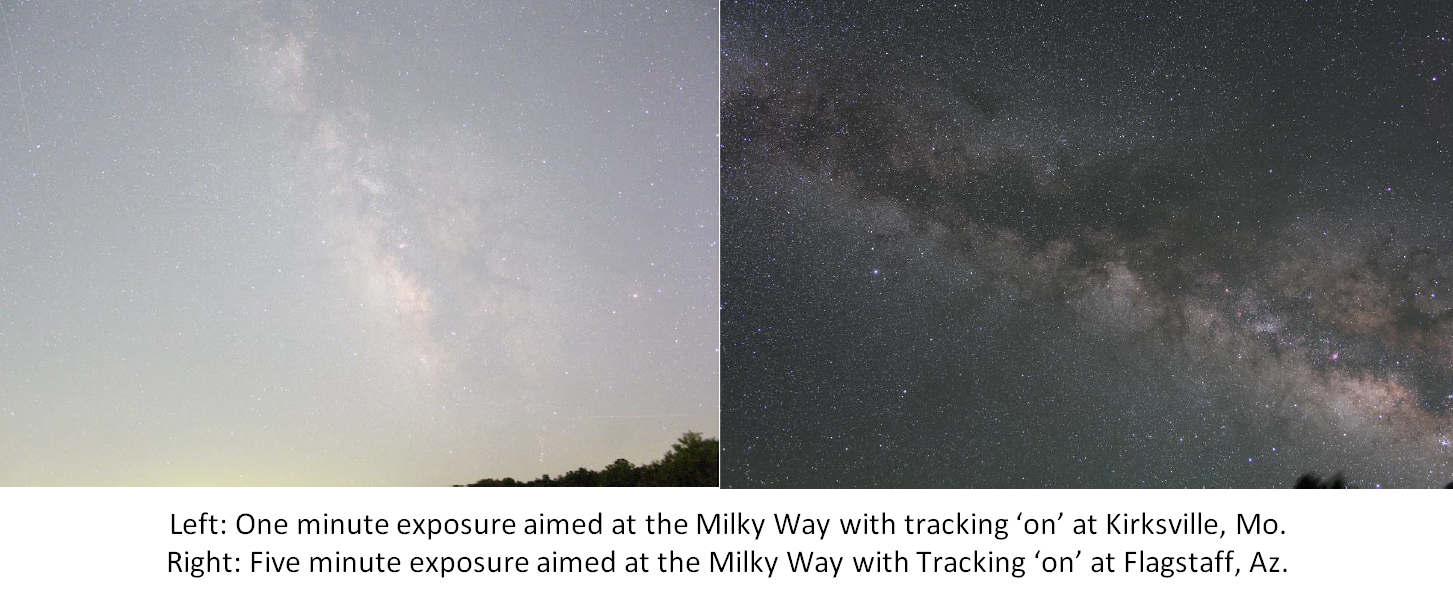Research Opportunities for Undergraduate Students
Truman students have several opportunities to conduct meaningful and consequential research in physics, astronomy, and related topics. Students have the opportunity to learn and develop several technical skills during their research experience. These include computer programing, data management and analyses, and science communication to other students and members of the community. We take special pride in involving both STEM and non-STEM majors in all of these activities. Some of the general skills students are likely to pick up as a result of doing astronomy research include:
- Managing and analyzing large datasets from “Sky Quality Meters” from across Missouri,
- Constructing all sky camera’s and analyzing all sky images to quantify light pollution,
- Participating in and leading outreach efforts related to “Dark Sky Advocacy”;
- Participate in understanding and explaining complex and exciting astronomical phenomena including binary stars and exoplanets.
- Managing and analyzing large datasets from space based missions such as Kepler, TESS, and JWST, and
- Learn and master Python and Mathematica programing.
Students who wish to continue and get involved in astronomy research can work with Truman faculty that are involved in a wide range of theoretical, numerical, computational, and Observational research projects. Student funding is available through the NASA-Missouri Space Grant Consortium, through the Office of Student Research at Truman State University. Many research students have successfully applied for and been granted the TruScholar summer undergraduate scholarship and the GIASR scholarships during the Fall and Spring semesters.
Below are details on some of the accomplished work and future plans. For further questions, please contact gokhale@truman.edu.
Dark Skies
Quantifying Light Pollution
Over the last five years, we have established a ‘Dark Sky group’ on the Truman campus consisting of approximately 3-5 students and two research advisors, one each from Truman State University (TSU) and the Moberly Area Community College (MACC). Students have used light sensors and an all-sky-camera to monitor the levels of light pollution at different locations around Kirksville, and near Flagstaff, Arizona. Some of these light sensors are controlled by Raspberry-pi microcomputers, and some are fully automatic sensors which are ideal for remote observations, when power-outlets and a wireless network are unavailable. We have successfully applied for grants amounting to close to $15,000 at Truman State University to install light pollution friendly ‘light shields’ on ‘unfriendly’ light fixtures.
The primary focus of our outreach efforts this year has been to initiate the process of certifying Thousand Hills State park (about 5 miles from the Truman campus) as an “Urban Night Sky Place”. To this end, students have compiled a light-inventory on the park, and are working with park officials to rectify “bad” light fixtures and have designed an outreach program involving students at Truman State, the local county library, and Thousand-Hills State park rangers. We have been monitoring the level of light pollution in and around Kirksville, and in Thousand Hills State park. Over the past two years, with the help of the Missouri chapter of the International Dark Sky Association (https://darkskymissouri.org/), we have extended this monitoring to other parks and towns in Missouri.
Research Objectives
The primary research questions we wish to continue to explore are:
- How do local weather conditions such as temperature, humidity, cloud over, and so on affect the sky brightness as measured by the SQMs? In particular, we want to investigate the impact on sky brightness of different types of clouds (high/low cirrus, thick/thin stratus, cumulus, cumulonimbus clouds etc.).
- In what way does sky brightness change as a result of installing warm colored lights and dark-sky friendly light shields?
We are addressing these research questions by using following resources that enable us to obtain sky brightness data in different ways.
- Sky Quality Meters: SQMs installed at 15 locations across the state of Missouri,
- All-Sky-Cameras: Build, Set up, and Calibrate FIVE all-sky-cameras (costing about $200 each) to be set up on a rotational basis at the above locations,
- Satellite Data: Use VIIRS satellite data as a benchmark to compare SQM and all-sky-camera measurements (https://www.lightpollutionmap.info/),Students are using freely available resources to obtain the weather data in order to address the primary research question:
- Weather data: Weather data obtained from the weather station from the nearest airport to the SQM location (https://www.ncdc.noaa.gov/cdo-web/datatools/lcd).
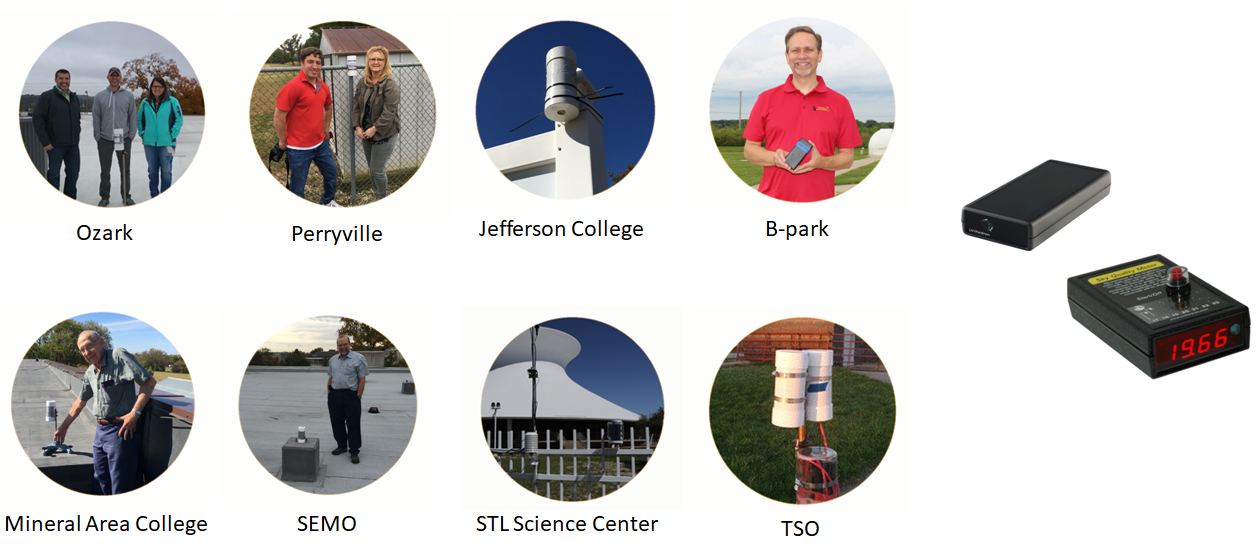
Volunteers and some of the installations on the “Sky Quality Meter” program hosted by the Missouri chapter of the International Dark Sky Association. Volunteers manage the SQM installations and periodically download data and send it to Truman State. Students at Truman State analyze these data and publish reports on the level of sky brightness at various locations (see below). On the right are example images of a handheld SQM and a “automatic” battery-operated SQM that is housed in the PVC housing seen on some of the installation images.
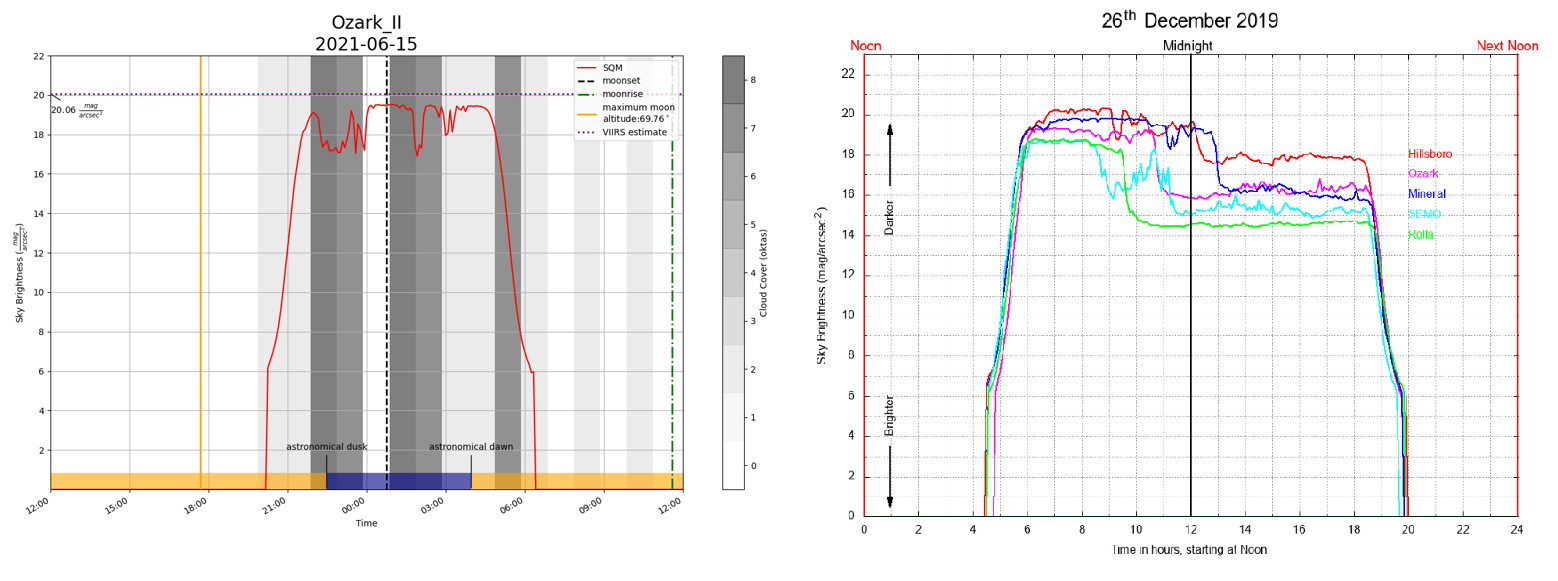
Left Panel: An example plot generated for the SQM measurements (red curve, left scale), with cloud cover (measured in oktas, right scale), superposed in greyscale. The presence of clouds leads to an increase in sky brightness (lower SQM values) due to reflection of upward directed light back into the sensor. These data are from the Community Center in the City of Ozark for the night of 15th June 2021. Moonset is around 1:00 AM.
Right Panel: A comparison between various stations on the same night shows the onset of clouds across Missouri.

Left panel: Three GoNet “all-sky” cameras. The set up consists of a raspberry-pi microcomputer, a camera and a fish eye lens, GPS, and a digital display, housed in a 3-D printed weather-proof housing (Red, Green).
Right panel: Six example images from an overnight deployment of an all-sky-camera on July 22, 2021 at a location near Wentzville, Missouri.
TALKS
Dark Sky Advocacy
The inappropriate or excessive use of artificial light – known as light pollution – can have serious environmental consequences for humans, wildlife, and our climate. Components of light pollution include:
- Glare – excessive brightness that causes visual discomfort
- Skyglow – brightening of the night sky over inhabited areas
- Light trespass – light falling where it is not intended or needed
- Clutter – bright, confusing and excessive groupings of light sources
Here, we list a few highlights related to this outreach and activism. All students contributed to all aspects of the work described below, but only the lead students are named for each category.
Inventory of Lights on the Truman State campus (Nicholas Rackers, Madi Polniak, Samantha Seggerman): This activity was carried out by the students from the “Freshman Symposium” class (See Figure III). Groups of about 20 students mapped different parts of the campus with the help of the above-mentioned senior student preceptors. Students counted over 250 “globe lights”, with about half of them being lower CCT 3000K (yellowish) lights with “dark sky reflectors” installed to redirect light towards the ground. About half the fixtures are completely unshielded with CCT 5000K (blue-white) lights. TSU is in the process of replacing the blue-white LED lights to yellow LEDs, and we are working towards changing all lights to amber colored, CCT 2300K lights.
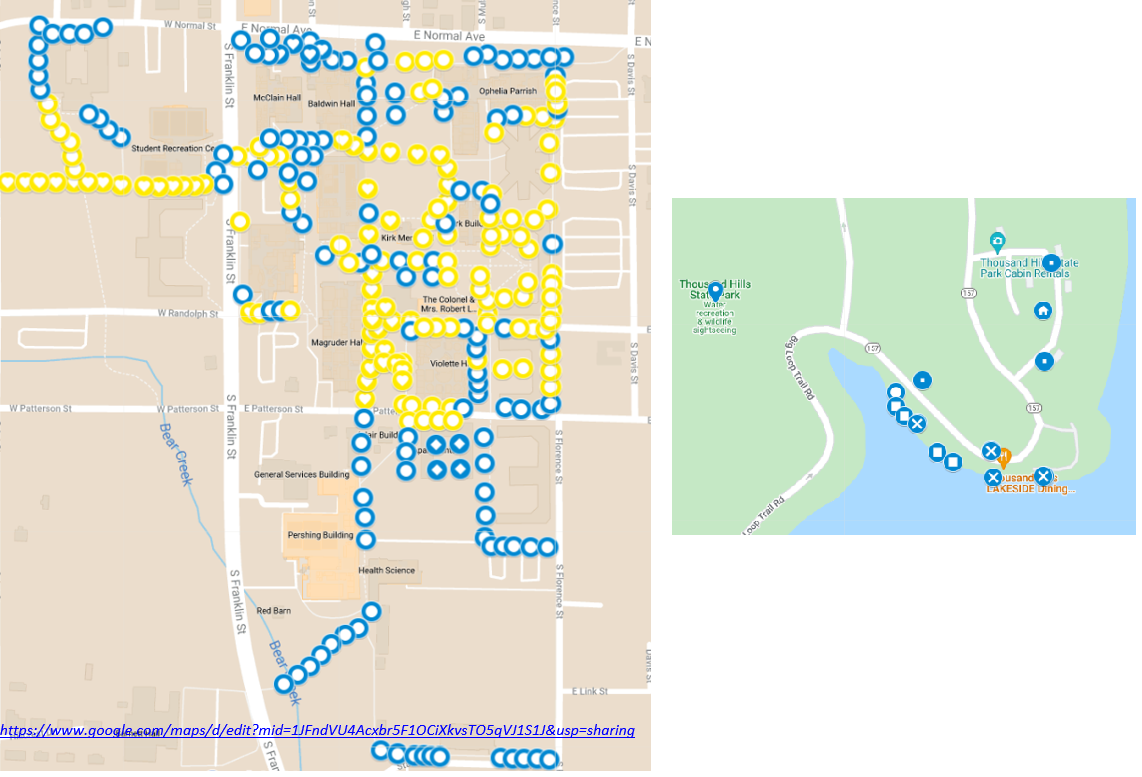
Left panel:250+ outdoor “globe lights” on the Truman State University campus. Students from the “Freshman Symposium” class mapped different parts of the campus with the help of senior student preceptors including Nicholas Rackers, Madi Polniak, and Samantha Seggerman. Blue circles indicate unshielded T = 5000K lights, whilst yellow indicates T = 3000K lights. Hearts indicate fixtures with “dark sky reflectors”.
Right panel: Inventory of lights at Thousand Hills State park. Crosses indicate sideways facing bright lights, squares indicate well shielded LED lights, dots indicate unshielded street lamps. All lights are close to T = 5000K, something the park plans to rectify soon.
Inventory of Lights at Thousand Hills State Park (Alex Rositz): As part of the initiative to obtain UNSPlaces status for Thousand Hills State park, students walked around the lit part of the park and created an inventory of lights (See Figure III). This inventory was presented to the park superintendent, who is in the process of replacing some of the lights, installing motion sensors on others, and finding funding options to replace about 10 lights. Our goal is to work with the park officials and develop good lighting practices on campgrounds and the marina, and then apply for UNSPlaces status with the International Dark Sky Association (by January 2023).
International Dark Sky Week Programs (All students): Apart from creating general awareness about the issue of light pollution, students are engaged in conducting polls and celebrating the International Dark Sky Week (April 22-30 2022). Students have invited the City manager, representatives from Ameren, the city Mayor, administrators from Truman State, Park rangers, and other prominent members of the Kirksville community to these events, in particular to the event at the Planetarium on the 26th of April 2022. Students have prepared presentations, handouts, flyers (see Figure IV), and polls to engage these community members and Truman students. Students will lead discussions aimed at bringing about consensus on moving forward with the Thousand Hills UNSPlaces application and for initiating and implementing dark sky friendly practices in the Kirksville community.
Stargazing and outreach in Kirksville Community (Madi Polniak): Additionally, one of the students, Madison Polniak, has helped organize a series of “star party” events for 2022 at various locations in-and-around Kirksville (Truman Observatory, local county library, and Thousand Hills). Students have prepared handouts and activities related to dark sky issues to be distributed during these events (see Figure IV).
Community building across Campuses (All Students): Students supported by this grant have reached out to a group of students at the University of Missouri, Columbia (Mizzou) and are helping the Mizzou students set up a “dark sky group” on their campus. This contact was made through IDA-Missouri as Mizzou is keen on setting up a “student chapter” at Mizzou. Students discussed their experiences, event planning, outreach and activism. We hope to build on this relationship and organize joint-programs (f2f and on Zoom) in the coming months. Indeed, students are exploring the idea of reaching out to environmental and astronomy groups in various Universities across the state to establish local “student dark sky chapters” to help create awareness about light pollution, and then, promote good lighting practices in those communities.
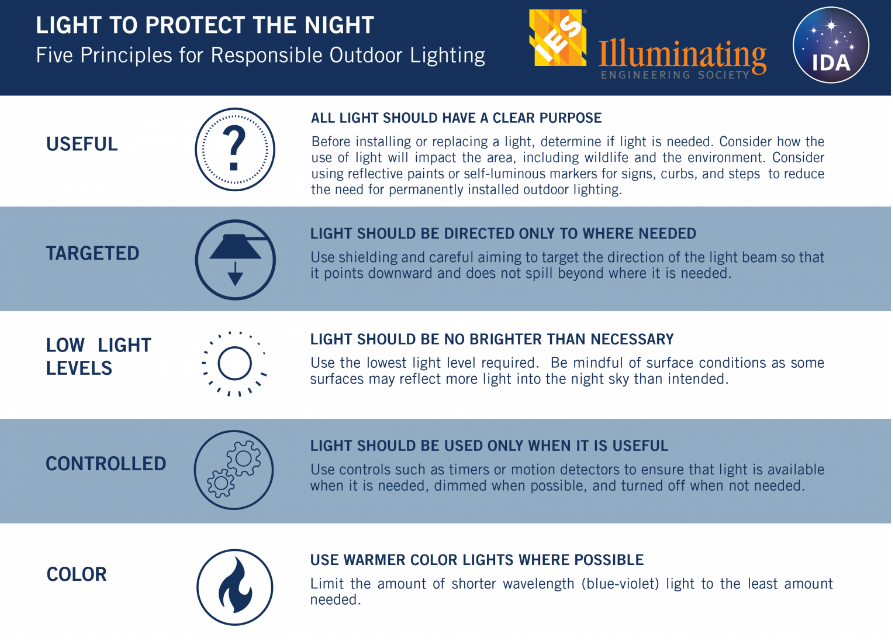
Observational Astronomy
Asymmetries in Eclipsing Binary Star light curves
Students use the fully automated 17-inch Planewave telescope at the Truman State Observatory and the 1-m NPOI telescope at Lowell Observatory to continue observations and analyses of the lightcurves of short period eclipsing binary stars. This project will involve collecting data over several nights, processing the images and then analyzing & interpreting them. Students will collect data in different filters and analyze the asymmetries in the resulting light curves. These asymmetries are related to the presence of starspots (or “hotspots”) on one or both components of the binary, and hence detailed analysis and modeling of these lightcurves provides useful insights into the properties of the starspots and/or “hot spots”. Star spots and hot spots can masquerade as exoplanets and cause “confusion” in the data-analyses pipelines and hence a better understanding of starspots (shape/size/lifetimes etc) is desired.
Below are lightcurves generated by students for three objects in three photometric filters (B, V, and R) using the 1-m NPOI telescope at Lowell. Students then fitted the data points with a 12-term Fourier fit, which is then used the quantify the asymmetries in the light curves. Additionally, the Fourier coefficients are used to confirm that LX Leo and V0354 UMa are W UMa-type EBs and MU Leo is a beta-Lyrae type EB.

Normalized flux for three eclipsing binary stars: LX Leo (left), V0354 UMa (center), and MU Leo (right) in the BVR filters. The Fourier fits (continuous curves) are plotted along with the blue, green, and red curves corresponding to B, V, and R filters, respectively. The average error in the flux for each measurement is approximately 0.003 and 0.005 for LX Leo & V0354 UMa respectively in all filters, and about 0.0002 for MU Leo in all filters. Error bars are not shown for the sake of clarity.
TESS Follow-up Observation Program (TFOP)
Students use the fully automated 17-inch Planewave telescope at the Truman State Observatory and the 42-inch NURO telescope at Lowell Observatory to confirm transits of known candidate planets. This project will involve collecting data over several nights, processing the images and then analyzing & interpreting them. We intend to collect data in different filters and analyze the similarities and differences in the resulting light curves. Our targets will be selected from the Kepler and TESS missions. In addition, students continue to contribute to the TESS follow-up team (TFOP) to work on distinguishing real exoplanet transits from blended eclipsing binaries. The primary goal of the TESS Follow-up Observing Program (TFOP) Working Group (WG) is to provide follow-up observations that will facilitate achievement of the Level One Science Requirement to measure masses for 50 transiting planets smaller than 4 Earth radii.
In Fall 2021 and Spring 2022, for example, students were responsible for selecting targets during our observing run (26thOct. 2021 to 29thOct. 2021) to utilize the entire night. The list of targets are shown in table below. With the exception of one short period eclipsing binary (V1393 Tau) all other targets were potential exoplanets. One of the primary objectives of the TFOP group is to study candidate exoplanet transits and determine of these are caused by nearby variable stars, usually eclipsing binaries, and thus eliminate these “false positives” from the list of possible exoplanets detected by the TESS mission. Students carried out data collection, reduction, and light-curve generation following the prescription by Dennis Conti of the TFOP group. This guide lays out the general principles involved in observing exoplanets and then described data reduction and analysis using the AstroImageJ software. The TFOP data submission process involves generation of several data and images files (see Figure 1 for examples) – this procedure is outlined in the TFOP Observation Guidelines document. Students followed this procedure and have successfully submitted data for three targets, and are working towards submitting data from the other three targets in the summer of 2022.
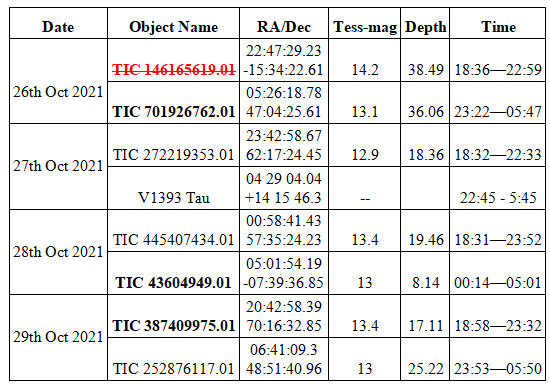
List of targets observed in Fall 2021 with the 1-m NPOI telescope at Lowell Observatory near Flagstaff, Arizona. The observations were carried out remotely. All targets except V1393 Tau (eclipsing binary) are potential exoplanets, and our analyses hope to “clear” them as such. Data analysis and submission of appropriate files as per the TFOP protocol has been completed for the objects shown in boldface.
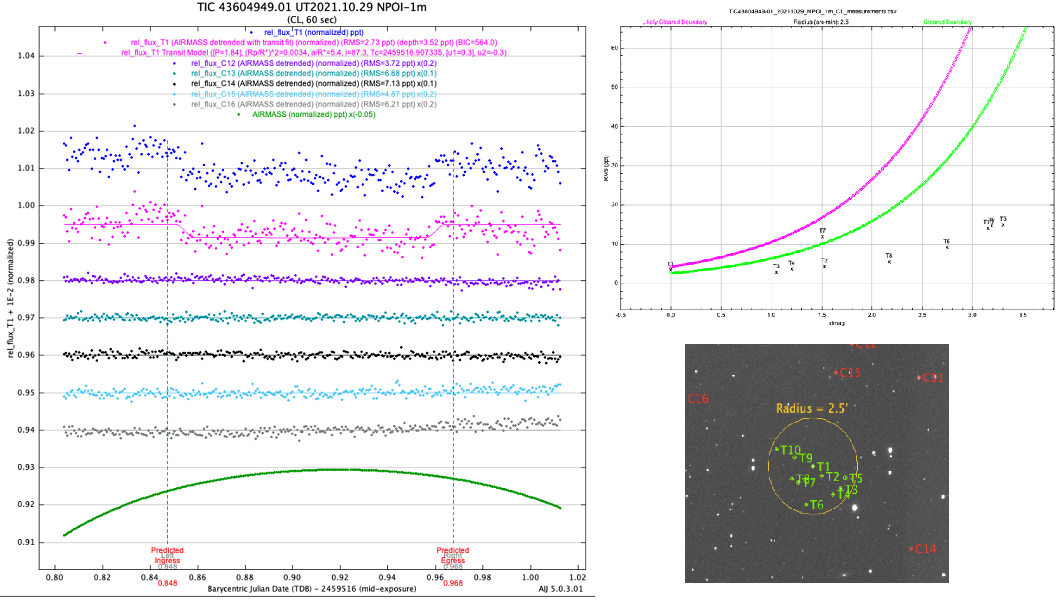
Left panel: Light curve of target candidate exoplanet (TIC 43604949.01, blue and magenta) along with light curves of comparison stars. The bottom right panel shows the target (T1) with other potential contaminating stars within a 2.5 arc-minute radius (yellow circle). Each of these are plotted on the graph on the top right, where any star below the green curve is ruled out as a contaminant, stars between the green and magenta curves are “likely cleared” contaminants and any stars above the magenta curve are not cleared. Based on these analyses, we can collude that the “dip” seen in the target lightcurve is almost certainly from the exoplanet candidate, and not from a nearby eclipsing binary star.
